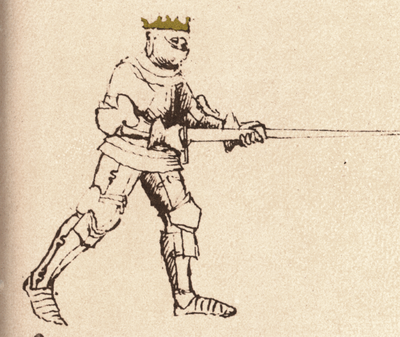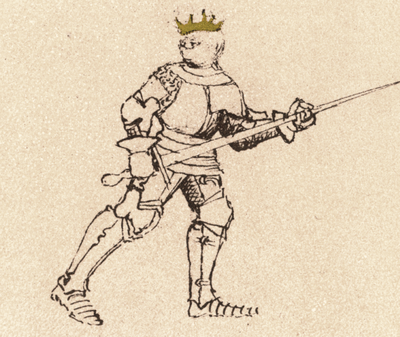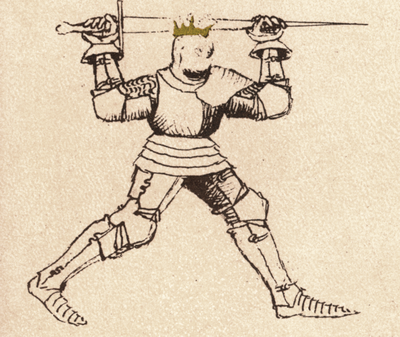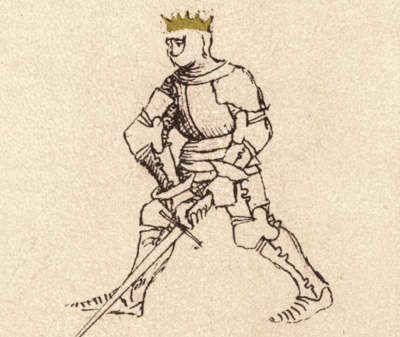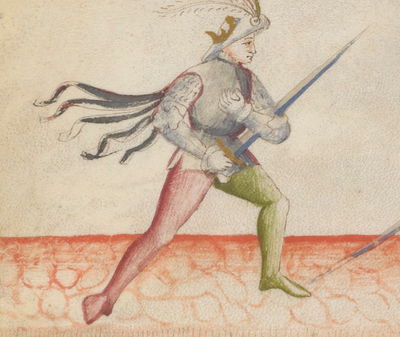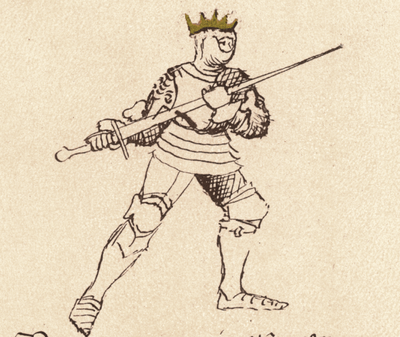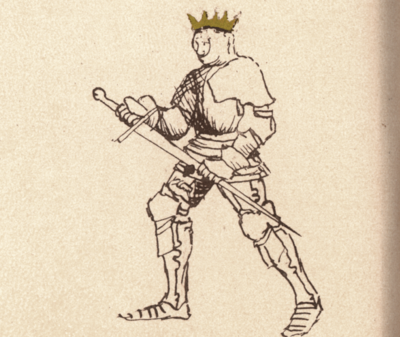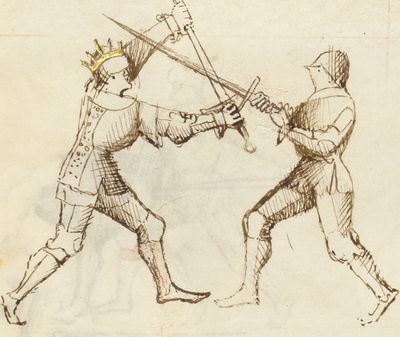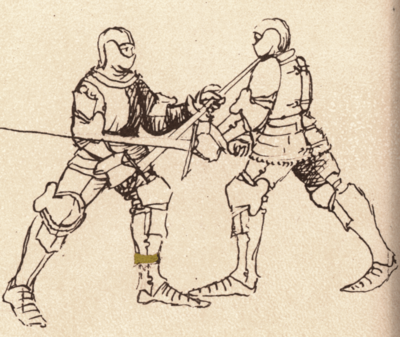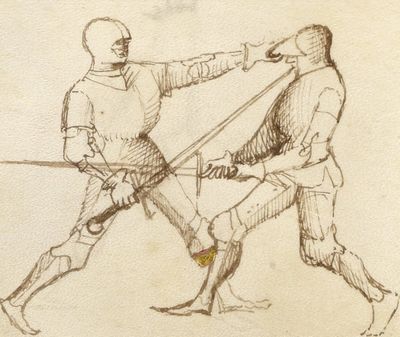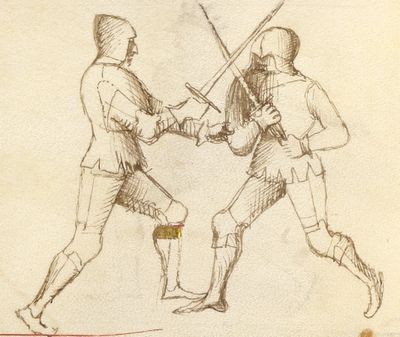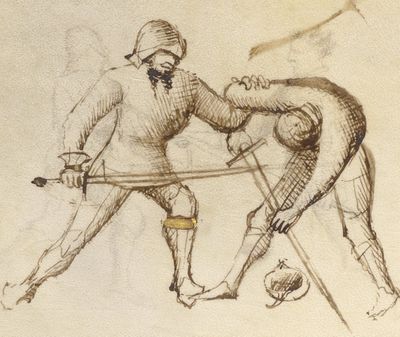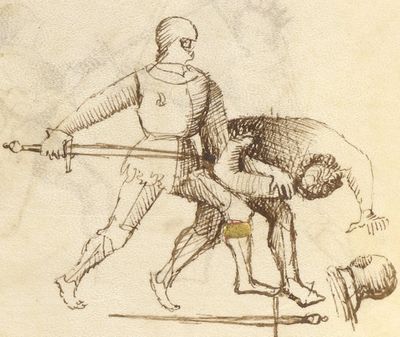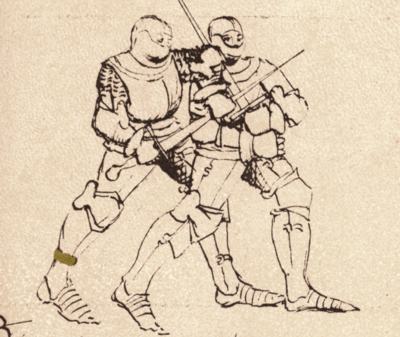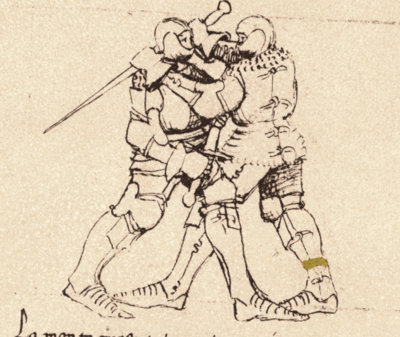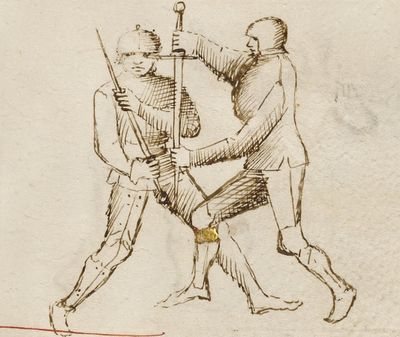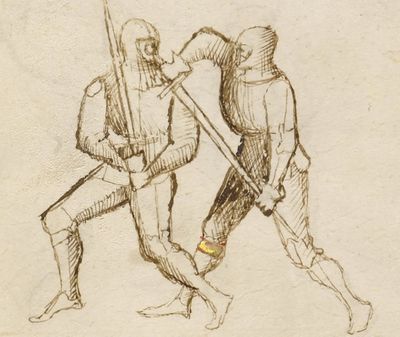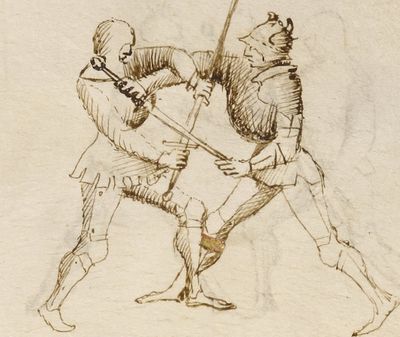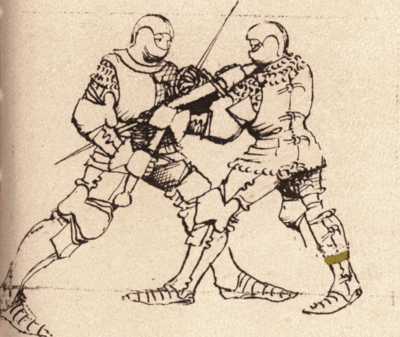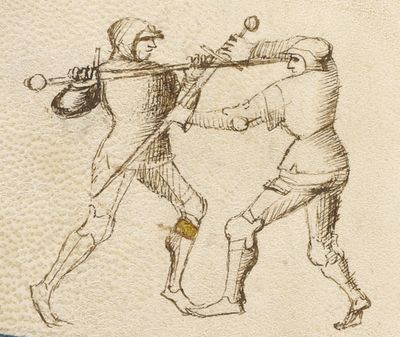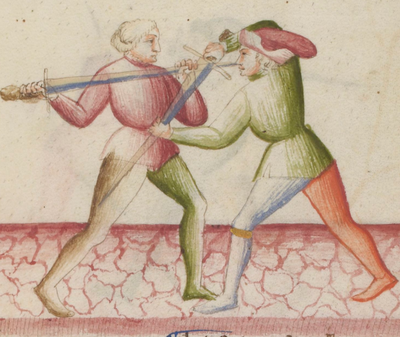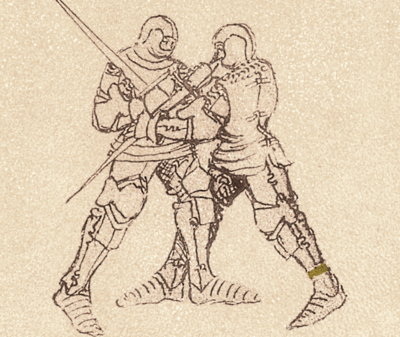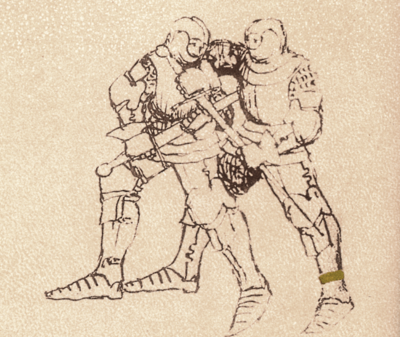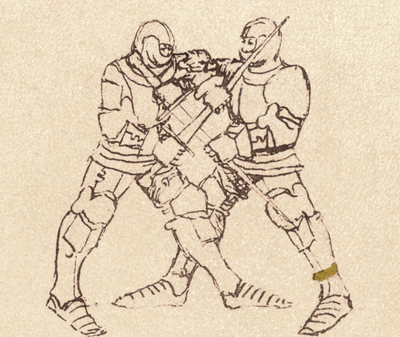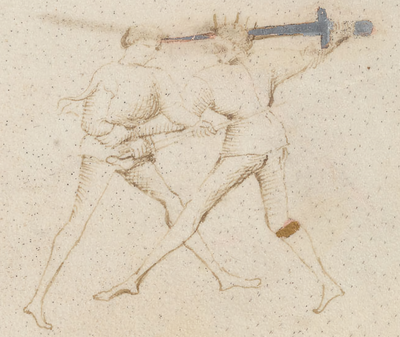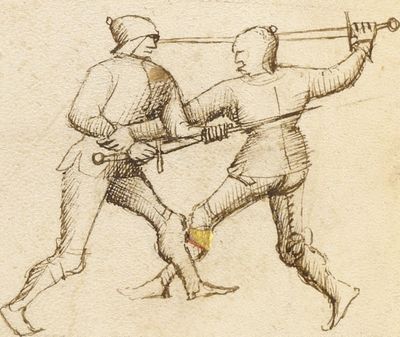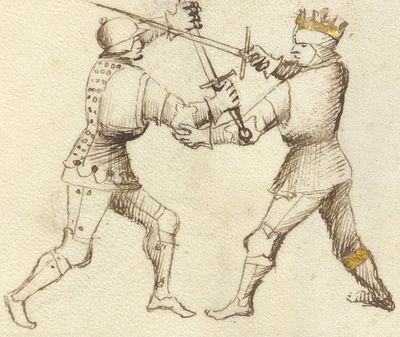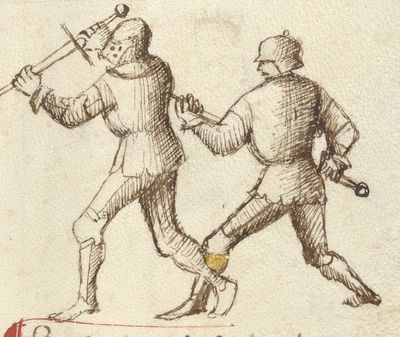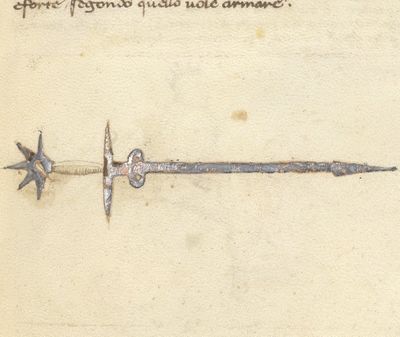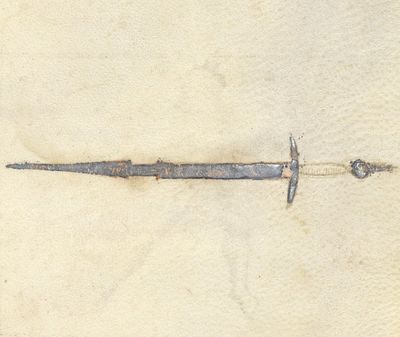|
|
You are not currently logged in. Are you accessing the unsecure (http) portal? Click here to switch to the secure portal. |
Difference between revisions of "Fiore de'i Liberi/Sword in Armor"
| (11 intermediate revisions by the same user not shown) | |||
| Line 1: | Line 1: | ||
| − | <noinclude><div style="width: | + | <noinclude><div style="width:240em;"></noinclude> |
| − | {| class=" | + | {| class="master" |
|- | |- | ||
| − | ! <p> | + | ! <p>Illustrations</p> |
| − | ! <p> | + | ! <p>Illustrations</p> |
| − | ! <p>''{{rating|B| | + | ! <p>''{{rating|B|Novati Translation}} by [[Michael Chidester]]''<br/>{{rating|B|Getty Translation}} by [[Colin Hatcher]]</p> |
| − | ! <p>''{{rating|C|Paris}} by [[Kendra Brown]] and [[Rebecca Garber]]''<br/>{{rating|B|Morgan}} by [[Michael Chidester]]</p> | + | ! <p>''{{rating|C|Paris Translation}} by [[Kendra Brown]] and [[Rebecca Garber]]''<br/>{{rating|B|Morgan Translation}} by [[Michael Chidester]]</p> |
| − | ! <p>[[ | + | ! <p>[[Trattato della scherma (MS M.383)|Morgan Transcription]] (1400s){{edit index|Trattato della scherma (MS M.383)}}<br/>by [[Michael Chidester]]</p> |
| − | ! <p>[[Fior di Battaglia (MS Ludwig XV 13)|Getty Transcription]]{{edit index|Fior di Battaglia (MS Ludwig XV 13)}}<br/> | + | ! <p>[[Fior di Battaglia (MS Ludwig XV 13)|Getty Transcription]] (1400s){{edit index|Fior di Battaglia (MS Ludwig XV 13)}}<br/>by [[Michael Chidester]]</p> |
| − | ! <p>[[Flos Duellatorum (Pisani Dossi MS)|Pisani Dossi Transcription]]{{edit index|Flos Duellatorum (Pisani Dossi MS)}}<br/>by [[ | + | ! <p>[[Flos Duellatorum (Pisani Dossi MS)|Pisani Dossi Transcription]] (1409){{edit index|Flos Duellatorum (Pisani Dossi MS)}}<br/>by [[Michael Chidester]]</p> |
| − | ! <p>[[Florius de Arte Luctandi (MS Latin 11269)|Paris Transcription]]{{edit index|Florius de Arte Luctandi (MS Latin 11269)}}<br/>by [[Kendra Brown]] and [[Rebecca Garber]]</p> | + | ! <p>[[Florius de Arte Luctandi (MS Latin 11269)|Paris Transcription]] (1420s){{edit index|Florius de Arte Luctandi (MS Latin 11269)}}<br/>by [[Kendra Brown]] and [[Rebecca Garber]]</p> |
|- | |- | ||
| Line 23: | Line 23: | ||
{{section|Page:MS M.383 10r.jpg|10r-t|lbl=10r}} | {{section|Page:MS M.383 10r.jpg|10r-t|lbl=10r}} | ||
| − | | | + | | <p><br/><br/><br/><br/><br/><br/></p> |
| + | |||
| + | {{section|Page:MS Ludwig XV 13 32v.jpg|32v-a1|lbl=32v-a}} | ||
| {{section|Page:Pisani-Dossi MS 25a.jpg|25a-t|lbl=25a}} | | {{section|Page:Pisani-Dossi MS 25a.jpg|25a-t|lbl=25a}} | ||
| {{section|Page:MS Latin 11269 19v.jpg|19v-t|lbl=19v}} | | {{section|Page:MS Latin 11269 19v.jpg|19v-t|lbl=19v}} | ||
| Line 29: | Line 31: | ||
|- | |- | ||
| | | | ||
| − | | [[File:Pisani-Dossi MS 25a-a.png| | + | | [[File:Pisani-Dossi MS 25a-a.png|400px|center]] |
| <p>[2] {{red|b=1|The Shortened Stance, the Serpent}}</p> | | <p>[2] {{red|b=1|The Shortened Stance, the Serpent}}</p> | ||
| Line 49: | Line 51: | ||
<p><br/><br/></p> | <p><br/><br/></p> | ||
| − | {{section|Page:MS Ludwig XV 13 32v.jpg|32v- | + | {{section|Page:MS Ludwig XV 13 32v.jpg|32v-a2|lbl=-}} |
| <p><br/></p> | | <p><br/></p> | ||
| Line 59: | Line 61: | ||
|- | |- | ||
| | | | ||
| − | | [[File:Pisani-Dossi MS 25a-b.png| | + | | [[File:Pisani-Dossi MS 25a-b.png|400px|center]] |
| <p>[3] {{red|b=1|The Stance of the True Cross}}</p> | | <p>[3] {{red|b=1|The Stance of the True Cross}}</p> | ||
| Line 89: | Line 91: | ||
|- | |- | ||
| | | | ||
| − | | [[File:Pisani-Dossi MS 25a-c.png| | + | | [[File:Pisani-Dossi MS 25a-c.png|400px|center]] |
| <p>[4] {{red|b=1|The Raised Serpent}}</p> | | <p>[4] {{red|b=1|The Raised Serpent}}</p> | ||
| Line 119: | Line 121: | ||
|- | |- | ||
| | | | ||
| − | | [[File:Pisani-Dossi MS 25a-d.png| | + | | [[File:Pisani-Dossi MS 25a-d.png|400px|center]] |
| <p>[5] {{red|b=1|The Middle Iron Gate}}</p> | | <p>[5] {{red|b=1|The Middle Iron Gate}}</p> | ||
| Line 148: | Line 150: | ||
|- | |- | ||
| − | | [[File:MS Latin 11269 19v-c.png| | + | | [[File:MS Latin 11269 19v-c.png|400px|center]] |
| − | | [[File:Pisani-Dossi MS 25b-a.png| | + | | [[File:Pisani-Dossi MS 25b-a.png|400px|center]] |
| <p>[6] {{red|b=1|The Archer's Stance}}</p> | | <p>[6] {{red|b=1|The Archer's Stance}}</p> | ||
| Line 156: | Line 158: | ||
<p>I am known as the Archer’s Guard, and I throw great thrusts as I step offline. And if strikes or thrusts come against me, I make a strong cover, and then immediately I strike with my counter. This is my skill, and I never vary from it.</p> | <p>I am known as the Archer’s Guard, and I throw great thrusts as I step offline. And if strikes or thrusts come against me, I make a strong cover, and then immediately I strike with my counter. This is my skill, and I never vary from it.</p> | ||
| − | <p>''[The Getty resembles the Pisani | + | <p>''[The Getty resembles the Pisani Dossi image.]''</p> |
| <p><br/></p> | | <p><br/></p> | ||
| Line 181: | Line 183: | ||
|- | |- | ||
| | | | ||
| − | | [[File:Pisani-Dossi MS 25b-b.png| | + | | [[File:Pisani-Dossi MS 25b-b.png|400px|center]] |
| <p>[7] {{red|b=1|The Stance of the Bastard Cross}}</p> | | <p>[7] {{red|b=1|The Stance of the Bastard Cross}}</p> | ||
| Line 211: | Line 213: | ||
|- | |- | ||
| | | | ||
| − | | [[File:MS Ludwig XV 13 33r-c.jpg| | + | | [[File:MS Ludwig XV 13 33r-c.jpg|400px|center]] |
| <p>[8] <em>With this cover I believe that I can waste anyone,<br/>Following that which you see the Scholar do.</em></p> | | <p>[8] <em>With this cover I believe that I can waste anyone,<br/>Following that which you see the Scholar do.</em></p> | ||
<p>This cover is made from the True Cross Guard, when I step diagonally offline. And so that you can see what can be done from this cover, my students will show the plays that follow it, and since they are experienced in mortal combat, they will show these skills without hesitation.</p> | <p>This cover is made from the True Cross Guard, when I step diagonally offline. And so that you can see what can be done from this cover, my students will show the plays that follow it, and since they are experienced in mortal combat, they will show these skills without hesitation.</p> | ||
| − | <p>''[In the Pisani | + | <p>''[In the Pisani Dossi, the Master is missing his crown.]''</p> |
| <p>''By using this covering, you would now be sure to repel whomsoever,<br/>Just as you will see the students play at any time.''</p> | | <p>''By using this covering, you would now be sure to repel whomsoever,<br/>Just as you will see the students play at any time.''</p> | ||
| Line 231: | Line 233: | ||
|- | |- | ||
| | | | ||
| − | | [[File:Pisani-Dossi MS 25b-d.png| | + | | [[File:Pisani-Dossi MS 25b-d.png|400px|center]] |
| <p>[9] <em>This thrust exits from the Master's cover,<br/>And the other plays hereafter may well arise.</em></p> | | <p>[9] <em>This thrust exits from the Master's cover,<br/>And the other plays hereafter may well arise.</em></p> | ||
| Line 251: | Line 253: | ||
|- | |- | ||
| | | | ||
| − | | [[File:MS Ludwig XV 13 33v-a.jpg| | + | | [[File:MS Ludwig XV 13 33v-a.jpg|400px|center]] |
| <p>[10] If I see my thrust cannot penetrate his chest, or his face due to his visor, I can lift his visor in order to thrust into his face. And if this does not satisfy me, I can apply other stronger plays.</p> | | <p>[10] If I see my thrust cannot penetrate his chest, or his face due to his visor, I can lift his visor in order to thrust into his face. And if this does not satisfy me, I can apply other stronger plays.</p> | ||
| | | | ||
| Line 261: | Line 263: | ||
|- | |- | ||
| | | | ||
| − | | [[File:MS Ludwig XV 13 33v-b.jpg| | + | | [[File:MS Ludwig XV 13 33v-b.jpg|400px|center]] |
| <p>[11] When I closed with this opponent, his armor prevented me from striking him as shown in the previous play. So instead I push strongly against his elbow and make him turn away. Let’s see now if his armor is strong enough when he is attacked from behind.</p> | | <p>[11] When I closed with this opponent, his armor prevented me from striking him as shown in the previous play. So instead I push strongly against his elbow and make him turn away. Let’s see now if his armor is strong enough when he is attacked from behind.</p> | ||
| | | | ||
| Line 271: | Line 273: | ||
|- | |- | ||
| | | | ||
| − | | [[File:MS Ludwig XV 13 33v-c.jpg| | + | | [[File:MS Ludwig XV 13 33v-c.jpg|400px|center]] |
| <p>[12] <br/><br/></p> | | <p>[12] <br/><br/></p> | ||
| Line 285: | Line 287: | ||
|- | |- | ||
| | | | ||
| − | | [[File:MS Ludwig XV 13 33v-d.jpg| | + | | [[File:MS Ludwig XV 13 33v-d.jpg|400px|center]] |
| <p>[13] I have you locked in the lower bind or “strong key”, and from this position you cannot escape regardless of how strong you are. I could hurt you or even kill you. I could stop to write a letter and you would not even be able to see what I was doing. You have lost your sword and your helmet, you have been humiliated<ref>Literally “lost your honor”.</ref> and you’ll soon be hurting.<ref>Literally “You’ll have short comfort.” The use of “festa” here is so as to rhyme with “testa” before it.</ref></p> | | <p>[13] I have you locked in the lower bind or “strong key”, and from this position you cannot escape regardless of how strong you are. I could hurt you or even kill you. I could stop to write a letter and you would not even be able to see what I was doing. You have lost your sword and your helmet, you have been humiliated<ref>Literally “lost your honor”.</ref> and you’ll soon be hurting.<ref>Literally “You’ll have short comfort.” The use of “festa” here is so as to rhyme with “testa” before it.</ref></p> | ||
| | | | ||
| Line 295: | Line 297: | ||
|- | |- | ||
| | | | ||
| − | | [[File:Pisani-Dossi MS 26a-a.png| | + | | [[File:Pisani-Dossi MS 26a-a.png|400px|center]] |
| <p>[14] <em>You go to the ground because of the point of the sword,<br/>And if I do not do you worse you will have a bargain.</em></p> | | <p>[14] <em>You go to the ground because of the point of the sword,<br/>And if I do not do you worse you will have a bargain.</em></p> | ||
| Line 313: | Line 315: | ||
|- | |- | ||
| | | | ||
| − | | [[File:Pisani-Dossi MS 26a-b.png| | + | | [[File:Pisani-Dossi MS 26a-b.png|400px|center]] |
| <p>[15] <em>You feel the sword that I have set at your neck<br/>And I will show you death on the ground.</em></p> | | <p>[15] <em>You feel the sword that I have set at your neck<br/>And I will show you death on the ground.</em></p> | ||
| Line 331: | Line 333: | ||
|- | |- | ||
| | | | ||
| − | | [[File:MS Ludwig XV 13 34r-b.jpg| | + | | [[File:MS Ludwig XV 13 34r-b.jpg|400px|center]] |
| <p>[16] When I move from my guard to a close range cover and am unable to strike you with a cut, I strike you with a thrust. If I cannot strike you with either, I strike you with the cross guard or with the pommel, depending on my preference.</p> | | <p>[16] When I move from my guard to a close range cover and am unable to strike you with a cut, I strike you with a thrust. If I cannot strike you with either, I strike you with the cross guard or with the pommel, depending on my preference.</p> | ||
| Line 343: | Line 345: | ||
|- | |- | ||
| | | | ||
| − | | [[File:MS Ludwig XV 13 34r-c.jpg| | + | | [[File:MS Ludwig XV 13 34r-c.jpg|400px|center]] |
| <p>[17] As you saw, the student who preceded me struck his opponent in the face with the crossguard of his sword. Thereafter he can quickly strike him in the face with his pommel, as you see depicted below.</p> | | <p>[17] As you saw, the student who preceded me struck his opponent in the face with the crossguard of his sword. Thereafter he can quickly strike him in the face with his pommel, as you see depicted below.</p> | ||
| | | | ||
| Line 353: | Line 355: | ||
|- | |- | ||
| | | | ||
| − | | [[File:MS Ludwig XV 13 34r-d.jpg| | + | | [[File:MS Ludwig XV 13 34r-d.jpg|400px|center]] |
| <p>[18] Also let me tell you that the student immediately before me who struck his opponent in the face with the pommel of his sword, could also have done what I do, that is, step with his right foot behind his opponent’s left leg, and then hook his opponent’s neck with his sword handle, in order to throw him to the ground as I do.</p> | | <p>[18] Also let me tell you that the student immediately before me who struck his opponent in the face with the pommel of his sword, could also have done what I do, that is, step with his right foot behind his opponent’s left leg, and then hook his opponent’s neck with his sword handle, in order to throw him to the ground as I do.</p> | ||
| | | | ||
| Line 363: | Line 365: | ||
|- | |- | ||
| | | | ||
| − | | [[File:Pisani-Dossi MS 26a-c.png| | + | | [[File:Pisani-Dossi MS 26a-c.png|400px|center]] |
| <p>[19] <em>If I turn myself close on your left side,<br/>Your sword will be lost from your right hand.</em></p> | | <p>[19] <em>If I turn myself close on your left side,<br/>Your sword will be lost from your right hand.</em></p> | ||
| Line 381: | Line 383: | ||
|- | |- | ||
| | | | ||
| − | | [[File:MS Ludwig XV 13 34v-a.jpg| | + | | [[File:MS Ludwig XV 13 34v-a.jpg|400px|center]] |
| <p>[20] This play also flows from the True Cross Guard, as follows when a student is in that guard, and an opponent comes against him and suddenly attacks him, then the student should step off the line and thrust his sword point into his face as you see me do here.</p> | | <p>[20] This play also flows from the True Cross Guard, as follows when a student is in that guard, and an opponent comes against him and suddenly attacks him, then the student should step off the line and thrust his sword point into his face as you see me do here.</p> | ||
| | | | ||
| Line 391: | Line 393: | ||
|- | |- | ||
| | | | ||
| − | | [[File:MS Latin 11269 16v-b.png| | + | | [[File:MS Latin 11269 16v-b.png|400px|center]] |
| <p>[21] <em>I have wasted your hand, you can feel it well,<br/>And I could strike your face with my pommel.</em></p> | | <p>[21] <em>I have wasted your hand, you can feel it well,<br/>And I could strike your face with my pommel.</em></p> | ||
| − | <p>''[In the Pisani | + | <p>''[In the Pisani Dossi, the player is wearing the garter.]''</p> |
| <p>''You can perceive that I have beaten<ref>Lit. “pounded to pulp”.</ref> your hand<ref>Lit. “palm”.</ref> with great wounds.<br/>I would be able to make a bargain at the same time using the hilt.''</p> | | <p>''You can perceive that I have beaten<ref>Lit. “pounded to pulp”.</ref> your hand<ref>Lit. “palm”.</ref> with great wounds.<br/>I would be able to make a bargain at the same time using the hilt.''</p> | ||
| Line 410: | Line 412: | ||
|- | |- | ||
| | | | ||
| − | | [[File:Pisani-Dossi MS 26b-a.png| | + | | [[File:Pisani-Dossi MS 26b-a.png|400px|center]] |
| <p>[22] <em>Here I waste your hand by coming to a bind<br/>Which is so strong that I care nothing for your armor.</em></p> | | <p>[22] <em>Here I waste your hand by coming to a bind<br/>Which is so strong that I care nothing for your armor.</em></p> | ||
| <p>''Here I strike you truly in the hand; the thing<br/>I sought out with great pains will henceforth be bound to me, because he expresses contempt for grand weapons.''</p> | | <p>''Here I strike you truly in the hand; the thing<br/>I sought out with great pains will henceforth be bound to me, because he expresses contempt for grand weapons.''</p> | ||
| Line 424: | Line 426: | ||
|- | |- | ||
| | | | ||
| − | | [[File:Pisani-Dossi MS 26b-b.png| | + | | [[File:Pisani-Dossi MS 26b-b.png|400px|center]] |
| <p>[23] <em>I will send you to the ground with my hilt,<br/>And I will then waste you with my point.</em></p> | | <p>[23] <em>I will send you to the ground with my hilt,<br/>And I will then waste you with my point.</em></p> | ||
| <p>''Learned in my art, I will turn your body face-up onto the ground.<br/>Henceforth, I will penetrate your gloomy self with my point.''</p> | | <p>''Learned in my art, I will turn your body face-up onto the ground.<br/>Henceforth, I will penetrate your gloomy self with my point.''</p> | ||
| Line 440: | Line 442: | ||
|- | |- | ||
| | | | ||
| − | | [[File:Pisani-Dossi MS 26b-c.png| | + | | [[File:Pisani-Dossi MS 26b-c.png|400px|center]] |
| <p>[24] <em>You will either lose the sword from your left hand,<br/>Or you will go to the ground because of this entry I make.</em></p> | | <p>[24] <em>You will either lose the sword from your left hand,<br/>Or you will go to the ground because of this entry I make.</em></p> | ||
| <p>''Either you will leave your very own sword from the left part,<br/>Or you, gloomy one, are going into the ground. You cannot deny this.''</p> | | <p>''Either you will leave your very own sword from the left part,<br/>Or you, gloomy one, are going into the ground. You cannot deny this.''</p> | ||
| Line 456: | Line 458: | ||
|- | |- | ||
| | | | ||
| − | | [[File:MS M.383 11v-d.png| | + | | [[File:MS M.383 11v-d.png|400px|center]] |
| <p>[25] <em>This catch makes me safe from your sword:<br/>Mine is free and yours is imprisoned.<br/>And the fourth play which is in the art of the poleax,<br/>Troubles the sword in armor with this play.</em></p> | | <p>[25] <em>This catch makes me safe from your sword:<br/>Mine is free and yours is imprisoned.<br/>And the fourth play which is in the art of the poleax,<br/>Troubles the sword in armor with this play.</em></p> | ||
| + | |||
| + | <p>''[In the Pisani Dossi, the Master is missing his crown.]''</p> | ||
| <p>''This taking makes <me> safe from your sword. Therefore it happens that<br/>Truly my <sword> is free. On the other hand, yours remains imprisoned.<br/>And moreover, the sword brings about the play which is considered the fourth.<br/>In the art of the two-edged axe,<ref>''Bipennifera'' (two-edged axe) likely refers to the poleaxe, even though in that section the manuscript refers to it as “three-pointed” instead.</ref> [the reader] will easily see the same kind of thing.''</p> | | <p>''This taking makes <me> safe from your sword. Therefore it happens that<br/>Truly my <sword> is free. On the other hand, yours remains imprisoned.<br/>And moreover, the sword brings about the play which is considered the fourth.<br/>In the art of the two-edged axe,<ref>''Bipennifera'' (two-edged axe) likely refers to the poleaxe, even though in that section the manuscript refers to it as “three-pointed” instead.</ref> [the reader] will easily see the same kind of thing.''</p> | ||
| Line 472: | Line 476: | ||
|- | |- | ||
| | | | ||
| − | | [[File:MS Ludwig XV 13 34v-d.jpg| | + | | [[File:MS Ludwig XV 13 34v-d.jpg|400px|center]] |
| <p>[26] This is a good strong grapple: as he makes his grip on the opponent’s right arm, the student steps with his left foot behind opponent’s left foot, and thrusts the point of his sword into his face. He can also throw him to the ground to the student’s right.</p> | | <p>[26] This is a good strong grapple: as he makes his grip on the opponent’s right arm, the student steps with his left foot behind opponent’s left foot, and thrusts the point of his sword into his face. He can also throw him to the ground to the student’s right.</p> | ||
| | | | ||
| Line 482: | Line 486: | ||
|- | |- | ||
| | | | ||
| − | | [[File:MS Ludwig XV 13 35r-a.jpg| | + | | [[File:MS Ludwig XV 13 35r-a.jpg|400px|center]] |
| <p>[27] This is the counter to the Remedy Master and all of his students. It is the case that every counter you use against a Remedy Master will also break the plays of all of that Remedy Master’s students. And this is true for the spear, poleaxe, sword, dagger, and grappling, that is, for the entire art.</p> | | <p>[27] This is the counter to the Remedy Master and all of his students. It is the case that every counter you use against a Remedy Master will also break the plays of all of that Remedy Master’s students. And this is true for the spear, poleaxe, sword, dagger, and grappling, that is, for the entire art.</p> | ||
| Line 494: | Line 498: | ||
|- | |- | ||
| | | | ||
| − | | [[File:MS Ludwig XV 13 35r-b.jpg| | + | | [[File:MS Ludwig XV 13 35r-b.jpg|400px|center]] |
| <p>[28] I am the student of the Counter-Remedy Master who came before me and I complete his play as follows: when I have turned my opponent, I immediately strike him from behind, either under his right arm, or under his coif into the back of his head, or into his buttocks (excuse my language), or into the back of his knee, or in any other place where he is unprotected.</p> | | <p>[28] I am the student of the Counter-Remedy Master who came before me and I complete his play as follows: when I have turned my opponent, I immediately strike him from behind, either under his right arm, or under his coif into the back of his head, or into his buttocks (excuse my language), or into the back of his knee, or in any other place where he is unprotected.</p> | ||
| | | | ||
| Line 504: | Line 508: | ||
|- | |- | ||
| | | | ||
| − | | [[File:MS Ludwig XV 13 35r-c.jpg| | + | | [[File:MS Ludwig XV 13 35r-c.jpg|400px|center]] |
| <p>[29] This sword can be used as a sword or a poleaxe, and should not be sharpened from the guard down to one hand’s-width from the point. The point should be sharp and the sharp edge should be about a hand’s-width in length. The roundel below the hilt should be able to slide down the blade to a hand’s-width from the point and no further. The hilt needs to be strongly made with a heavy pommel with well-tempered spikes. The spikes should be well-tempered and sharp. The front of the sword should be as heavy as the back, and the weight should be from three and a half to five and a half pounds,<ref>A Medieval Italian pound was an approximate measure equal to 300-350 g, or 0.66 to 0.77 standard pounds. Fiore indicates here that the sword should be 5 to 7 [Italian] pounds, so taking the upper and lower values as bounds, this gives a potential range of 3.3 to 5.4 lbs. Values are derived from this link: [http://www.personal.utulsa.edu/~marc-carlson/history/measure.html Measurement in the Middle Ages].</ref> depending on how big and strong the man is and how he chooses to be armed.</p> | | <p>[29] This sword can be used as a sword or a poleaxe, and should not be sharpened from the guard down to one hand’s-width from the point. The point should be sharp and the sharp edge should be about a hand’s-width in length. The roundel below the hilt should be able to slide down the blade to a hand’s-width from the point and no further. The hilt needs to be strongly made with a heavy pommel with well-tempered spikes. The spikes should be well-tempered and sharp. The front of the sword should be as heavy as the back, and the weight should be from three and a half to five and a half pounds,<ref>A Medieval Italian pound was an approximate measure equal to 300-350 g, or 0.66 to 0.77 standard pounds. Fiore indicates here that the sword should be 5 to 7 [Italian] pounds, so taking the upper and lower values as bounds, this gives a potential range of 3.3 to 5.4 lbs. Values are derived from this link: [http://www.personal.utulsa.edu/~marc-carlson/history/measure.html Measurement in the Middle Ages].</ref> depending on how big and strong the man is and how he chooses to be armed.</p> | ||
| | | | ||
| Line 513: | Line 517: | ||
|- | |- | ||
| − | | | + | | class="noline" | |
| − | | [[File:MS Ludwig XV 13 35r-d.jpg| | + | | class="noline" | [[File:MS Ludwig XV 13 35r-d.jpg|400px|center]] |
| − | | <p>[30] This other sword is fully sharpened from the hilt all the way to the point, except there is an unsharpened section in the middle<ref>The “terza” of the sword is the same as the “mezza spada” or middle of the blade.</ref> about a hand’s width, big enough for a gloved hand to be able to hold it there. Just like the previous sword, this sword should be sharp with a fine point. And the hilt should be strong with a heavy pommel and a sharp well-tempered spike.</p> | + | | class="noline" | <p>[30] This other sword is fully sharpened from the hilt all the way to the point, except there is an unsharpened section in the middle<ref>The “terza” of the sword is the same as the “mezza spada” or middle of the blade.</ref> about a hand’s width, big enough for a gloved hand to be able to hold it there. Just like the previous sword, this sword should be sharp with a fine point. And the hilt should be strong with a heavy pommel and a sharp well-tempered spike.</p> |
| − | | | + | | class="noline" | |
| − | | | + | | class="noline" | |
| − | | {{section|Page:MS Ludwig XV 13 35r.jpg|35r-d}} | + | | class="noline" | {{section|Page:MS Ludwig XV 13 35r.jpg|35r-d}} |
| − | | | + | | class="noline" | |
| − | | | + | | class="noline" | |
|} | |} | ||
Latest revision as of 21:32, 25 June 2021
Illustrations |
Illustrations |
Novati Translation |
Paris Translation |
Morgan Transcription (1400s) |
Getty Transcription (1400s) |
Pisani Dossi Transcription (1409) |
Paris Transcription (1420s) |
|---|---|---|---|---|---|---|---|
| [No Image] | [1] We are six guards for armored fencing, We are 6 masters who are very knowledgeable in the art of armed fighting, and each one of us is an expert in this art. Hand-held weapons do not worry us, because we know how to defend against any cuts and thrusts that may come our way. |
We are in deeds of arms six greatly skillful acts. Here begins the sword in armor, and great will be the Master who can make these plays. These Masters are six and each one is in guard; they will not delay in covering and striking. And whoever knows most in this, their art, will have a part in all of the following plays. |
[10r] Aqui comenza la spada de armizare. Ben sera magistro chi tali zoghi sara fare. Gli magistri sono sie e zaschuno in guarda. De covrir e ferir non farano niente tarda. E chi piu savera in questa lor arte, de tuti lor zoghi che segueno avera parte. |
[32v-a] ¶ Noii semo ·ⅵ· Magistri che savemo ben armezare. E zaschuno de noii quell'arte sa ben fare. E de arme manuale curamo ben pocho de tagli e de punte se defendemo s'el zi fa loco. |
[25a] Noii semo sei guardie in fato de armiçar. |
[19v] ¶ Sex sumus in factis armorum valde periti | |
[2] The Shortened Stance, the Serpent I am the Shortened Stance, the Serpent, I am the Short Serpent Guard, and I consider myself superior to the other guards. And when I thrust those I strike will be well-marked. |
I am the Short Position itself. I am called by the proper name Serpentinus; In the Shortened Stance, the Serpent, do I want to come. If you are not well-armored, I will make you feel it! I hold myself better than any other guard for striking with the point. Because of my edges, I sign myself with the cross, and nothing can you do to me. In armor and without I want to prove it. |
[10r-a] In posta breve la serpentina io voio venire. Se tu non e bene armato ben te lo faro sentire per ferir de punta meior delle altre guardie mi tegno. Perche delli tagli cum la crose mi segno e niente mi pon fare. In arme e senza arme lo voio provare. |
· Posta Breve la serpentina · Io son posta breve la serpentina meglor dele altre mi tegno, A chi daro una punta ben gli parara lo segno. |
[25a-a] Io son posta breve la serpentina |
[19v-a] ¶ Sum situs ipse brevis. vocor et sub nomine recto | ||
[3] The Stance of the True Cross I am the stance called the True Cross I choose to use the True Cross Guard against you. And your thrust will fail to strike me. I will make cover to your attack as I make my step, and my thrust will strike you without fail. Neither you or the other guards concern me, because I am so well versed in the art of armed fighting that my crossing cannot fail me. Step, cross and strike, and this art will never fail you. |
In this Position of the Leopard,[1] I truly observe the Serene One, I am the Stance of the True Cross which I want to make to counter you. Your thrusts will not enter into me. I cover myself from you in the step that I make and my thrust will injure you without fail, so that you and the other guards can do little to me. I know armored fencing so well that I can never fail in the crossing (for stepping, crossing, and striking, the art wants these things without fail), and I break all your thrusts and I certainly will not fail: I come over and through, I go under the point and upward. |
[10r-b] Io son posta de vera crose che contra ti voio fare. In mi la tue punte non pon entrar. De ti me covriro in lo passare che faro. E de punta te feriro senza falo. Che ti e lle altre guardie pocho me pono fare. Tanto so bene lo armizare. Che non posso falire lo incrosare. Che in lo passare e in lo incrosar, e in lo ferire, l'arte vole a questo non falir. E rompo tute tue punte, e non faliro per certo vene oltre, e tra voii basso, la punta voi erto. |
· Posta de vera crose · [32v-b] ¶ Posta di vera crose ch'e contra ti voglio fare, In mi le toi punte no pon entrare. De ti me covriro in lo passare che faro, e de punta te feriro, senza fallo, Che ti e'le altre guardie pocho mi pon fare, tanto so bene lo armizare che non posso fallire lo incrosare, che in lo passar e in lo incrosar, e in lo ferire, l'arte vole questo a non fallire. |
[25a-b] Io son posta chiamata vera crose |
[18r-b] ¶ Inque situ aspecto leopardi nempe serenum | ||
[4] The Raised Serpent I am the Raised Serpent, I am the High Serpent and I am well positioned to give great underhand thrusts, since I begin high but end low. I will throw a great thrust into you as I step. That is my skill and I do it well. Your cuts do not concern me in the slightest, because when it is time to hand out great thrusts, you’ll get a large portion from me. |
I am called Serpentinus, and Raised. And, point high, I am the Serpent and I am High and well-armored. I quickly make great underhand thrusts because I am high and return down low. I'll drive a strong thrust to you with a step: this is my art and I know how to do it well. I have not a care for your edges, for I know the art and I will give you the better part of my point. |
[10r-c] Sompuo[!] serpentino son lo soprano, e ben armado grande punte butto subito sotto mane, che son in erto e torno al piano. Una forte punta te butiro cum la passare. Ella e mia arte che lo so ben fare, delli tuoi tagli non me curo niente tanto so in l'arte. Che de grande punte io te daro grande parte. |
·· Sonno serpentino lo soprano · [32v-c] ¶ Sompno[!] serpentino son lo soprano, e ben armado grande punte zetto sotto mano, che son in erto, e torno al piano. Una forte punta ti butiro cum lo passare. Ella e mia arte che la so ben fare. Di toi tagli non me curo niente tanto so in l'arte, che de grande punte io ti daro gran parte. |
[25a-c] E son sonno serpentino Lo sovrano |
[18r-a] ¶ Serpentinus ego vocor / et sopranus, et alta | ||
[5] The Middle Iron Gate I am the Iron Gate in the Middle: My name is Middle iron Gate, and whether you are armoured or unarmored I make strong thrusts. I step offline with my left foot and I put a thrust into your face. I can also place my point and blade between your arms in such a way that I will put you into the middle bind, as depicted and identified earlier. |
I am the guard in the formerly established Middle Iron Gate. Of Iron, I am called the Middle Gate, because in armor or out I give strong thrusts. And I will step out of the way with my left foot and thrust my point in your face, or I will enter [with] my point and with the edge between your arms and force you into the Middle Bind (which was previously depicted and named). |
[10r-d] De ferro son chiamada mezana porta perche in arme e senza e fazo le punte forte. E passaro fuora de strada cum lo pe stancho, e ti mezo una punta in lo volto. Overo che la punta e cum lo taglo enfra gli toii braçi intrero per modo che io te metiro in la ligadura mezana. In quella ch'e denanci dipenta e nominada. |
· Porta de ferro La mezana · [32v-d] ¶ Porta di ferro la mezana son chiamata, per che in arme e senza e fazo le punte forte. E passaro fora de strada cum lo pe stancho e'te metero una punta in lo volto, overo che cum la punta e'cum lo taglio enfra li toi brazzi intrara per modo che io te mettero in ligadura mezana, in quella ch'e denanzi penta e nomenada. |
[25a-d] In porta de fero io son la meçana |
|||
[6] The Archer's Stance I am the Archer's Stance, the sentinel, I am known as the Archer’s Guard, and I throw great thrusts as I step offline. And if strikes or thrusts come against me, I make a strong cover, and then immediately I strike with my counter. This is my skill, and I never vary from it. [The Getty resembles the Pisani Dossi image.] |
Here the sword will shift into a Malignant Position by penetrating; The Archer's Stance, by this name I am called. Great thrusts I give while stepping out of the way. And if you come against me with a blow of the edge, I make a good cover and quickly I strike my counter. This is my art and it does not change. |
[10v-a] Posta sagittaria son per nome chiamata, grande punte io zeto passando fora de strada, e si me ven contra colpo o taglio io fazo bona coverta, e subito io fiero lo mio contrario. Aquesta e mia arte che non svario. |
Posta Sagittaria [33r-a] ¶ Porta[!] sagittaria son per nome chiamada, grande punte e zetto passando fora de strada. E si me ven contra'colpo o taglio, io fazzo bona coverta e subito io fiero lo mio contrario. Questa si'e mia arte in la'qual non svario. |
[25b-a] Io son posta sagitaria la çentille |
|||
[7] The Stance of the Bastard Cross Of the Stance of the Cross, I am the Bastard, I am the Hybrid Cross Guard, and I am related to the True Cross Guard, in that anything it can do, I can do also. I make strong covers, thrusts or cuts, usually avoiding your strike by stepping offline, and my strikes are my greatest asset. |
I am the Position consecrated[4] as the True Cross by many masters. Of the True Cross I am the Bastard Stance (Posta di Crose Bastarda); that which she can do, I also choose to do. For my strategy, I make good covers, thrusts, and cuts, always while voiding blows out of the way, and with my blows I make my greatest bargain. |
[10v-b] Di vera crose son bastarda posta. Zo che ella po far voluntiera lo fazo. Bone coverte e punte e tagli fazo per usanza. Sempre schivando gli colpi fora de strada. E deli mie colpi io fazo grandissima derada. |
· Posta de crose bastarda · [33r-b] ¶ Posta di crose bastarda son di vera crose, Zo che la po fare volontiera lo fazzo. Bone coverte, e punte, e tagli fazo per usança sempre schivando gli colpi fora di'strada. E di miei colpi fazzo grandissima derada. |
[25b-b] De posta de crose io son bastarda |
[19v-b] ¶ Sum situs, et dicor crux multis vera magistris. | ||
[8] With this cover I believe that I can waste anyone, This cover is made from the True Cross Guard, when I step diagonally offline. And so that you can see what can be done from this cover, my students will show the plays that follow it, and since they are experienced in mortal combat, they will show these skills without hesitation. [In the Pisani Dossi, the Master is missing his crown.] |
By using this covering, you would now be sure to repel whomsoever, I come with this cover from the Stance of the True Cross, stepping out of the way to the side. And you will see what I can do from this cover; through my Scholars I can show it, because they make my complimentary plays (those that are for combat to the death). The art they will show without a doubt. |
[10v-c] De posta de vera crose io son ensudo cum questa coverta passando fora de strada ala traversa. E di questa coverta si vedera quello aquello ch'io posso fare. Per gli mie scolari lo posso mostrare. Che li fazano li miei zoghi in complimento. Aqui gli che son da combater ha oltranza, l'arte[5] monstrarano senza dubitanza. |
[33r-c] ¶ De posta di vera crose io son ensudo cum questa coverta passando fora de strada ala traversa. E di questa coverta si vedera quello ch'io posso fare, per gli miei scolari lo posso mostrare, Ch'elli farano gli miei zoghi in complimento, quegli che sono de combatter a oltranza, L'arte mostrarano senza dubitanza. |
[25b-c] Per questa coverta crederia çaschun guastar |
[18r-c] ¶ Hac nunc tectura quemcumque refellere credas / | ||
[9] This thrust exits from the Master's cover, I am the first student of the Master who came before me, and I make this thrust from his cover. You should also know that you can make this thrust from the True Cross Guard and from the Hybrid Cross Guard. As the opponent makes his thrust, the Master or his student who is waiting in one of these guards (or posts) keeps his body low and steps offline crossing the opponent's sword, with his point high into the opponent's face or chest, and with the hilt of his sword kept low, as shown here. [In the Getty, the Scholar's opponent's right foot is forward.] |
I would do other plays if ever it will be pleasing; I am the first Scholar of the Master that came before me, and I make this thrust because it is from his cover. Also, I say that this thrust could quickly be made from the Stance of the True Cross and from the Stance of the Bastard Cross, and I say that immediately as the player throws a thrust to the Master (or Scholar) who was in the aforesaid guards (or stances), the Master (or Scholar) should move lower with his body and step out of the way, crossing the way and thrusting upwards to his face or chest (the cross of the sword held low) as is depicted here. |
[10v-d] E son lo primo scolar delo magistro che m'e denanci, e aquesta punta fazo che la ese della sua coverta. Anchora digo che della posta de vera crose, a de posta de crose bastarda po se fare aquesta punta e digo de subito zoe come lo zugadore tra una punta alo magistro o scolar che fosse in le dite guardie, overo poste, lo magistro overo scolar de andare basso cum la persona e pasar fora de strada atraversando la strada, E cum la punta erta al volto overo al petto cum lo mantenir della spada a basso come dipento aqui. |
[33r-d] ¶ E son lo primo scolaro del magistro che m'e denanzi. Questa punta fazo per che ella esse di sua coverta. Anchora digo che dela posta di vera crose, e de posta de crose bastarda se po fare questa punta, e digo de subito zoe comme lo zugadore tra una punta alo magistro o scolar che fosse in le ditte guardie overo poste lo magistro lo magistro[6] overo scolar de andar basso cum la persona e passar fora de strada traversando la spada del scolaro, e cum la punta erta al volto overo al petto, E cum lo mantenir dela spada basso, come qui depento. |
[25b-d] Dela coverta delo magistro ese questa punta |
[18v-a] ¶ A tectura exit cuspis haec ima magistri. | ||
[10] If I see my thrust cannot penetrate his chest, or his face due to his visor, I can lift his visor in order to thrust into his face. And if this does not satisfy me, I can apply other stronger plays. |
[33v-a] ¶ Quando io vezo che la mia punta no po intrare in lo petto ne in lo volto per la visera, io levo la visera e si gli metto la punta in lo volto. E se questo no me basta io mi metto alli altri zoghi piu forti. |
||||||
[11] When I closed with this opponent, his armor prevented me from striking him as shown in the previous play. So instead I push strongly against his elbow and make him turn away. Let’s see now if his armor is strong enough when he is attacked from behind. |
[33v-b] ¶ Quando io veni a le strette cum questo zugadore a sai lo ferido di denançi e per le arme, niente me zova. Ma per lo cubito lo penzero forte che lo faro voltare Se le suoii arme sarano di dredo forte, voro lo provare. |
||||||
[12] When I saw that my sword was ineffective against you, I quickly applied this grappling technique. I believe, see and feel that your armor will be useless to you when I put you in this strong lower bind, which is shown further in the next[7] picture. |
Indeed, by means of this lower bind you will depart on your face. |
[33v-c] ¶ Quando io vidi che cum la spada, niente ti posseva fare. Subito io presi questa presa d'abrazare, che io creço, e vezo, e sento che le arme non te valerano niente, che ti metero in la forte ligadura de sotto in questa che m'e dredo posta, Io ti faro fare subito la mostra. |
[17v-c] ¶ Inferiore quidem nexura stratus abibis, | ||||
[13] I have you locked in the lower bind or “strong key”, and from this position you cannot escape regardless of how strong you are. I could hurt you or even kill you. I could stop to write a letter and you would not even be able to see what I was doing. You have lost your sword and your helmet, you have been humiliated[8] and you’ll soon be hurting.[9] |
[33v-d] ¶ In la ligadura de sotto e chiave forte t'o serado per si fatto modo che tu no poii ensire, e forza non ti val niente. Stentar ti posso, e'la morte ti posso dare una lettera scriveria che no me'llo porissi vedare. Tu non ai spada ne armadura di testa. tu ai pocho honore e farai breve festa. |
||||||
[14] You go to the ground because of the point of the sword, This play flows from the first Master who showed the True Cross Guard or the Hybrid Cross Guard, as follows: when the opponent makes a thrust at the Student who is waiting in guard, the student quickly steps off line to make cover, and counters with a thrust to the opponent’s face. Then the student advances his left foot behind[10] his opponent’s lead foot as shown, in order to throw him to the ground, using the point of his sword to hook around the opponent’s neck. |
You will depart on your face, with the point of the sword in the ground, When the Scholar that came before me [9] cannot finish the player with a thrust, he advances his left foot behind [the player's] right. And the point of his sword he thrusts under [the player's] throat to throw him to the ground as is depicted here. |
[11r-a] Quando lo scolar che m'e denanci non po fare lo zugadore cum la punta, e llo acrese lo suo pe stancho dredo lo suo dritto. E lla punta de sua spada gle mette sotto, la gola per butarlo in terra como aqui dipento. |
[34r-a] ¶ Questo zogo esse del primo nostro magistro de posta di vera crose e dela bastarda, zoe, Quando uno gli tra una punta e'llo scolaro l'aspetta in la guardia sua, e subito passa ala coverta fora de strada e tra gli una punta in lo volto, e cum lo pe stancho acresse de fora del suo pe ch'e denanzi per questo modo ch'e depento per butarlo in terra che la punta dela spada gl'avança oltra lo'collo. |
[26a-a] Tu va in terra per la punta dela spada |
[18v-c] ¶ Cuspide mucronis in terram stratus abibis. | ||
[15] You feel the sword that I have set at your neck Also let me point out that if the Student has moved to close range, and finds himself unable to destroy his opponent with his sword, then he should use his sword to grapple as shown, that is, he should cast his sword to his opponent’s neck, then step with his right foot behind the opponent’s left foot, and throw him to the ground to the right. |
I hold the point above the neck, and you feel that. This Scholar that came before me [14], if he cannot throw the player to the ground with the point of his sword and with his left foot outside of [the player's] right, he steps with his right foot in front of [the player's] left and throws his sword to his neck. And this play I make on his behalf. |
[11r-b] Aquesto scolar ch'e denanci de mi s'ello non po butar lo zugadore in terra cum la punta de sua spada, e cum lo suo pe stancho dredo lo suo dritto, ello passa cum lo pe dritto dredo lo suo stancho, e la spada gle butta al collo. E aquesto zogo io lo fazo icon in suo scambio. |
[34v-b] ¶ Anchora digo che quando un scolaro e venudo ale strette, che vezando ch'ello non po guastare lo compagno cum sua spada, ch'ello si de metter all'abrazare cum sua spada in questo modo zoe, che lo scolaro debia buttar la spada sua al collo del zugadore, e'lo suo pe dritto debia metter dredo lo pe stancho del zugadore, e butarlo in terra a man dritta. |
[16r-b] ¶ Colla super teneo mucronem. sentis et istud. | |||
[16] When I move from my guard to a close range cover and am unable to strike you with a cut, I strike you with a thrust. If I cannot strike you with either, I strike you with the cross guard or with the pommel, depending on my preference. And when I choose to play at close range, and my opponent believes I intend to use my sword, I switch to grappling when this gives me an advantage, or, if not, I can strike him in the face with my cross guard as I told you before, whichever I like. |
[34r-b] ¶ Quando io vegno dela guardia in la coverta stretta, se non posso ferir de taglio, io fiero de punta E se de questi doi non posso ferire, io fiero del elzo, o del pomo. E questo si fa segondo che gl'intelletti sono E quando io son chossi ale strette, e'llo zugador crede pur dela spada voglio zugare. io mi metto all'abrazare, se io vezo che mi sia avantazo, E se non, io lo fiero del elzo in lo volto come denançi detto segondo che a'mi pare che meglio sta. |
||||||
[17] As you saw, the student who preceded me struck his opponent in the face with the crossguard of his sword. Thereafter he can quickly strike him in the face with his pommel, as you see depicted below. |
[34r-c] ¶ Come voii vedeti che lo scolaro che m'e denançi fieri lo zugadore in lo volto cum lo elzo di sua spada, pr presta mente apresso lo po ferire cum lo pomo in lo volto come veder poteti qui di sotto. |
||||||
[18] Also let me tell you that the student immediately before me who struck his opponent in the face with the pommel of his sword, could also have done what I do, that is, step with his right foot behind his opponent’s left leg, and then hook his opponent’s neck with his sword handle, in order to throw him to the ground as I do. |
[34r-d] ¶ Anchora dico che questo scolaro che m'e denanzi che fieri lo zugadore cum lo pomo dela spada in lo volto, che ello avarave possudo fare come io fazo, zoe acresser lo pe dritto dredo lo suo stancho. E lo mantenir de sua spada meter lo al suo collo per butar lo in terra come io fazo. |
||||||
[19] If I turn myself close on your left side, This student is unable to strike his opponent effectively,[12] so he transitions to grappling as follows: he places his sword point to the inside of his opponent’s right arm. Then the student slides his sword and his left arm under the opponent’s right arm, so as to throw him to the ground, or lock him in the lower bind, known as the “strong key”. |
The sword will fall on your right side. Again I, who am the fourth Scholar, say that our Master can make this play from the cover which he has made—that is, that he should step with his right foot forward, and he should thrust the point of his sword under [the player's] right arm, and then follow the sword with his left arm. And when he has passed the [player's] right arm with his left arm behind the [player's] elbow, he will twist him into the Under Bind without a doubt. That which he has not done, I do for him—he will have the honor, and I the trouble. |
[11r-c] Anchora digo io che son lo quarto scolaro che lo nostro magistro po fare aquesto zogo per la coverta che ello ha fatta zoe che ello de passar cum lo pe dritto innanci. E lla punta della sua spada debia meter sotto lo suo dritto brazo. E cum lo brazo stancho seguisca la spada. E quando ello e passato cum lo suo brazo br stancho, lo suo dritto per sotto lo cubito. Ello revolta in la ligadura sottana senza dubito. Quelo che non a fatto per lui lo fazo. Ello porta lo honore e mi lo impazo. |
[34v-c] ¶ Questo scolaro no possando ferire lo zugadore cum danno, si vole metter al'abrazare per questo modo zoe, che lo scolar mette la sua spada dentro parte della man dritta dello zugadore. E que[ll] fa lo scolaro per intrar cum sua spada e cum lo suo brazzo stancho, sotto lo brazzo dritto del zugadore per sbaterlo in terra, overo per metterlo in ligadura de sotto zoe in la chiave forte. |
[26a-c] Si io me volto streto dela parte riverssa |
[16r-d] ¶ Dexteriore tui cadet ensis parte / sinistra | ||
[20] This play also flows from the True Cross Guard, as follows when a student is in that guard, and an opponent comes against him and suddenly attacks him, then the student should step off the line and thrust his sword point into his face as you see me do here. |
[34v-a] ¶ Anchora questo zogho esse de posta di vera crose per tal modo, zoe. che quando uno scolaro e in quella posta, e uno gli ven incontra, che subito in lo suo trar del zugadore, che lo scolar debia fora de strada passare, e'la punta gli metta in lo volto chome vedeti aqui fare. |
||||||
[21] I have wasted your hand, you can feel it well, [In the Pisani Dossi, the player is wearing the garter.] |
You can perceive that I have beaten[13] your hand[14] with great wounds. My Master has shown me that when I am armored and someone wants to thrust his point in my face in this way, I should thrust the edge of my sword under his left hand and I should step with my right foot behind his left, and in this fashion I can strike his face with my pommel or with my elbow, as can do this Scholar who is after me. If I can perform such a play, it would not fail me. [In the Morgan, both figures wear garters. It's unclear if this Scholar should also wear a Master's crown.] |
[11r-d] Lo mio magistro m'a mostrado che quando io son armado. E uno mi vole metere per tale modo la punta in lo volto. Che io debia meter lo taio della mia spada sotto la sua man stancha. E debia passar cum lo pe dritto dredo lo suo stancho, e per tal modo gle poro ferire cum lo pomo overo cum l'elzo in lo volto. Come po questo scolar che m'e dredo far. S'io lo passo fazo tale zogo non me po falire. |
[26a-d] La man t'o guasta, tu lo poii ben sentir |
[16v-b] ¶ Tu sentire potes. quam magno vulnere palmam[15]
| |||
[22] Here I waste your hand by coming to a bind |
Here I strike you truly in the hand; the thing Again, as the Scholar who came before [21] said, I will not fail in that I could make these two plays that are after me—that is, the first play strikes with the pommel to the face and slams you to the ground; the other (which is the second) follows, that if I can advance my right foot and the cross of my sword, then with that I strike you in the ear and in the cheek, and in that way you will go to the ground without fail. |
[11v-a] Aquello che dise lo scolaro ch'e denanci non falla che io ti posso fare aquesti dui zoghi che dredo me stano, zoe lo primo ferire cum lo pomo in lo volto, e sbaterti in terra. L'altro che segue ch'e lo segondo, quello se po fare acresere lo pe dritto e lo mantenir dela spada, e cum quello lo fiera in la orechia, e in la guanza, per tal modo andera in terra senza dubitanza. |
[26b-a] Aqui te guasto le man per vegner a'ligadura |
[16v-d] ¶ Hic ferio te nempe in manu / ut nexura sit inde | |||
[23] I will send you to the ground with my hilt, |
Learned in my art, I will turn your body face-up onto the ground. The previous Scholar of the Master [22] is well-informed. With my pommel, I strike you in the face and then I throw you to the ground, in such a way that neither your breastplate nor your helmet will save you. [In the Morgan, the Scholar's sword is behind his opponent's.] |
[11v-b] Lo scolaro ch'e denanzi dello magistro, e bene informado che delo pomo te fiero in lo volto e ti sbatero riverso in terra, per tale modo che non ti zovara pancirone ne cervilera. |
[26b-b] Cum lo mantiner in terra io te mando |
[17r-b] ¶ Doctus in arte mea resupino pectore vertam | |||
[24] You will either lose the sword from your left hand, |
Either you will leave your very own sword from the left part, This play has not failed, as said the second scholar that came before [22], because I could come to this play and strike you in the ear and in the cheek, and I hold myself certain of sending you to the ground. You will go to the ground and I will remain upright. [In the Morgan, the player faces away from the scholar as in the previous play.] |
[11v-c] Aquesto zogo non ho falato, come ha ditto lo segondo scolaro ch'e denanci che io posseva venire ad aquesto zogo che te fiero in la orechia e in la guanza, de mandarte in terra io mi tegno certo. Tu andarai al piano e mi staro in erto. |
[26b-c] O dela man mancha tu lassara la spada |
[17r-d] ¶ Vel linques ensem proprium de parte sinistra. | |||
[25] This catch makes me safe from your sword: [In the Pisani Dossi, the Master is missing his crown.] |
This taking makes <me> safe from your sword. Therefore it happens that I have little concern for the Master nor for his Scholars. I do this counter against him with good measure: that is, when he comes with the cover, I beat the elbow of his left arm with my left arm, and because of this he cannot make a defensive grapple and he can be harmed. Again another counter I could make: I could turn his elbow with my left hand. Such a play is done well both armored and unarmored. |
[11v-d] Dello magistro ne de suoii scolari pocho fazo cura. Questo contrario fazo contra lu cum bona misura, zoe quando ello vene cum la coverta, e io cum lo mio stancho brazo rebato lo suo stancho brazo cubito. E per tal mo cosi preso defesa non po fare e po essere offeso. Anchora altro contrario poseva fare. Cum la mia mane stancha per lo suo cubito lo posseva voltar. Che tal zogo in arme e senza arme ben se po fare. |
[26b-d] Questa presa me fa seguro de tua spada |
||||
[26] This is a good strong grapple: as he makes his grip on the opponent’s right arm, the student steps with his left foot behind opponent’s left foot, and thrusts the point of his sword into his face. He can also throw him to the ground to the student’s right. |
[34v-d] ¶ Questa si'e una presa forte e bona, che fatta la presa lo scolar mette allo zugadore lo suo pe stancho dredo lu pe stancho del zugadore. E lla punta dela sua spada gli mette in lo volto. Anchora lo po buttar in terra inverso man dritta. |
||||||
[27] This is the counter to the Remedy Master and all of his students. It is the case that every counter you use against a Remedy Master will also break the plays of all of that Remedy Master’s students. And this is true for the spear, poleaxe, sword, dagger, and grappling, that is, for the entire art. Let me return to address the Remedy Master: when he is making his cover, the Counter-Remedy Master places his left hand behind his opponent’s right elbow and gives it a powerful push, turning him in order to strike him from behind as you see drawn next. |
[35r-a] ¶ Questo si'e lo contrario dello magistro ch'e remedio e di tutti gli soi scolari, Che vera cosa si'e che zaschun contrario che ven fatto allo magistro rimedio, quello contrario rompe lo zogo dello magistro rimedio e di tutti soii scolari. E questo dico di lanza Azza spada daga e abrazzare e di tutta l'arte. Tornemo a dire dello magistro rimedio. Questo magistro contrario si mette la sua mane mancha dredo lo cubito dritto dello zugadore che fa la coverta delo magistro remedio, E si gli da volta per forza per ferirlo de dredo como vedreti qui dredo. |
||||||
[28] I am the student of the Counter-Remedy Master who came before me and I complete his play as follows: when I have turned my opponent, I immediately strike him from behind, either under his right arm, or under his coif into the back of his head, or into his buttocks (excuse my language), or into the back of his knee, or in any other place where he is unprotected. |
[35r-b] ¶ Io son scolaro dello magistro contrario che m'e denanzi e complisco lo suo zogho. Quando lo zugadore e voltado subito io lo fiero di dredo sotto lo brazzo suo dritto. E per sotto lo camaglio in la coppa dela testa, overo in le nadeghe del culo cum riverencia, overo sotto gli zinochi, overo in altro logo che trovo discoverto. |
||||||
[29] This sword can be used as a sword or a poleaxe, and should not be sharpened from the guard down to one hand’s-width from the point. The point should be sharp and the sharp edge should be about a hand’s-width in length. The roundel below the hilt should be able to slide down the blade to a hand’s-width from the point and no further. The hilt needs to be strongly made with a heavy pommel with well-tempered spikes. The spikes should be well-tempered and sharp. The front of the sword should be as heavy as the back, and the weight should be from three and a half to five and a half pounds,[22] depending on how big and strong the man is and how he chooses to be armed. |
[35r-c] ¶ Questa spada scusa per spada e per Azza, e non de tagliare del elço in fin uno somesso apresso la punta e delli inanze vol tagliare, e aver fina punta, e'lo taglio vol esser di lungeza un somesso. E lla rodeletta ch'e sotto lo elzo vol posser corere in fin uno somesso apresso la punta e non piu. E llo elzo vol esser ben temperado, e aver bona punta, e'llo pomo vol esser grave. E quelle punte volen esser ben temperade e ben agude. E la spada vole esser grave di dredo, e lizera denanzi. E vole esser di peso de ·ⅴ· a ⅶ· libre. E segondo che l'omo e grande e forte, segondo quello vole armare. |
||||||
[30] This other sword is fully sharpened from the hilt all the way to the point, except there is an unsharpened section in the middle[23] about a hand’s width, big enough for a gloved hand to be able to hold it there. Just like the previous sword, this sword should be sharp with a fine point. And the hilt should be strong with a heavy pommel and a sharp well-tempered spike. |
[35r-d] ¶ Questa altra spada si vole tagliar per tutto. Salvo che dello elzo in fin ala punta, ale doe parte, in mezo la terza dela punta non de taglier niente, a tanto spacio che una mane cum uno guanto larga mente gli possa intrare. E simile mente vole esser fina di taglio e de punta. E llo elzo vole esser forte, e'aguzzo e ben temperado e'llo pomo vole essere cum bona punta, e vole esser grave. |
- ↑ The position shown is called True Cross in Fiore’s other manuscripts, whereas Vadi calls it the Leopard’s Tail. Vadi also has a Serene Leopard, but it is Fiore’s Bastard Cross (which is called the True Cross in this manuscript).
- ↑ This may also be read as immanis but inanis is closer to the Italian
- ↑ Added later: "pro cum".
- ↑ Dicor could be a present passive indicative first person conjugation of either dicere (say, talk, name/call, et c) or dicare (dedicate, consecrate, deify, devote)—since the stances are usually named using the verb vocor, perhaps this was intentionally chosen as a pun. Also, in other Fiore texts this is the Bastard Cross.
- ↑ Interrupted by a sword.
- ↑ "lo magistro" appears twice, but neither is struck out.
- ↑ Here the word “subito” (immediately, quickly) means the picture following immediately after this one.
- ↑ Literally “lost your honor”.
- ↑ Literally “You’ll have short comfort.” The use of “festa” here is so as to rhyme with “testa” before it.
- ↑ Fiore actually says “outside the lead foot”, but I’ve translated it as a step behind the lead foot to make the meaning clearer.
- ↑ Corrected from "de".
- ↑ Fiore says unable to strike “cum danno”, “with danger”. “Effectively” seems a good choice here.
- ↑ Lit. “pounded to pulp”.
- ↑ Lit. “palm”.
- ↑ Added later: "scilicet manum".
- ↑ Bipennifera (two-edged axe) likely refers to the poleaxe, even though in that section the manuscript refers to it as “three-pointed” instead.
- ↑ Added later: "scilicet me".
- ↑ Likely haec
- ↑ Added later: "scilicet ensis".
- ↑ The period after habetur may be a later addition, since it overlaps the final stroke of the r.
- ↑ There's a light mark above Arte that looks like the abbreviation for haec.
- ↑ A Medieval Italian pound was an approximate measure equal to 300-350 g, or 0.66 to 0.77 standard pounds. Fiore indicates here that the sword should be 5 to 7 [Italian] pounds, so taking the upper and lower values as bounds, this gives a potential range of 3.3 to 5.4 lbs. Values are derived from this link: Measurement in the Middle Ages.
- ↑ The “terza” of the sword is the same as the “mezza spada” or middle of the blade.

